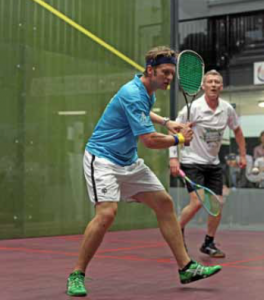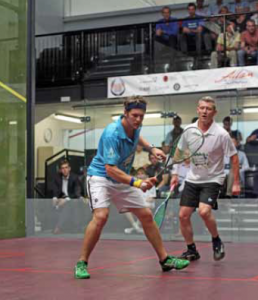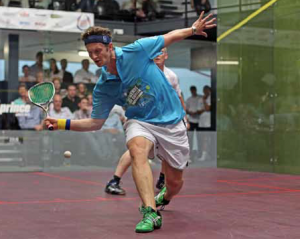By Richard Millman
This is going to sound weird from a Brit who knows practically squat about the national game, but even so, here’s something to get you scratching your head: What have Mario Soto and Greg Maddux got in common with great Squash players? No clue? Well here’s a hint:
 Your opponent has served the same serve at the same pace in the same place for the last fifteen serves. You think you have a handle on it and, as he shapes up to hit the next one, you steel yourself to return the ball, knowing already the pace and power that the ball is going to come at you. Your opponent swings—the same swing as always—but at the last moment he takes pace off of the ball and the serve comes to you much slower than did the previous fifteen. Even though you register the change in your mind, you’re already committed to your swing—which you release fractionally too early and you miss-hit the return, leaving your opponent with a loose ball and an opening that you didn’t mean to give him.
Your opponent has served the same serve at the same pace in the same place for the last fifteen serves. You think you have a handle on it and, as he shapes up to hit the next one, you steel yourself to return the ball, knowing already the pace and power that the ball is going to come at you. Your opponent swings—the same swing as always—but at the last moment he takes pace off of the ball and the serve comes to you much slower than did the previous fifteen. Even though you register the change in your mind, you’re already committed to your swing—which you release fractionally too early and you miss-hit the return, leaving your opponent with a loose ball and an opening that you didn’t mean to give him.
Yes my friend, you have just been the victim of a change-up serve.
Now you probably understand the reference to Mario Soto and Greg Maddux. Even from a limey. Change-up pitches and change-up serves use the same psychology.
Create a series of recognizable cues, mesmerize your opponent and lull them into becoming habituated and then, while seemingly delivering the same pitch/serve, change the pace at the last moment to create a miss-timed stroke.
Now don’t do this too often. Otherwise the opponent will become overly wary and actively seek the change-up.
It should be used sparingly so that the opponent’s adrenaline system finds it difficult, if not impossible, to adjust to.
The adrenaline system is the endocrine system within the human body that loads reactive capacity and ‘super-charges’ muscular reaction times.
However, because the adrenaline system is dependent on the previously mentioned ‘cues’, it is possible to pressurize the system in a number of ways.

First and foremost: the opponent, though primarily focused on the ball, peripherally notes movement in your racquet.
Advanced players don’t do this to try and ascertain ‘what’ shot you will play—merely ‘when’ you will play—so they can load their reactive capacity.
A simple way to limit this is the popularly termed ‘hold’ where a player freezes their racquet prep momentarily and suddenly strikes the ball with zero visible warning.
In this circumstance the adrenaline system is stalled until after the ball has been played, thereby making the reaction of the opponent ‘late’.
Secondarily, it is possible to ‘overload’ the opponent’s adrenaline system. In this scenario the striker holds the ball for such a long time that the retrieving player’s adrenaline system ‘overloads’ and releases adrenaline before the ball is played, thereby causing the would-be retriever to run before the ball is played—usually toward the direction that they think the opponent is most likely to hit. A guess in other words.
The third of the biochemical attacks is the ‘change-up’ that I mentioned at the beginning where the striker develops the opponent’s expectations by repeatedly using the same swing, pace and delivery rhythm until the opponent begins to anticipate the same production and becomes vulnerable to the well-executed ‘change-up’.
Change-ups can be from fast to slow or vice-versa. The key is to use the same outward appearance, to disguise the change well and to use it sparingly.
Used separately or together, these techniques will shroud your opponent in clouds of decision-making confusion. The mists of doubt will reduce them to uncertainty and panic, leading them to unnecessary and extra movement, frequently in completely the wrong direction or with an erroneous swing—or hopefully both!
One of the most famous exponents of all of these biochemical attacks on an opponent’s adrenaline system was, and still is, the amazing Jonathon Power. Power’s capacity to hoodwink his opponent by variously using sudden and explosive racquet acceleration, sudden and explosive racquet deceleration, masking of the ball with his body, and lulling his opponent into a false sense of security, only to then completely hoodwink them, is legendary.
 In the great dual of his competitive career with Peter Nicol, early in their amazing series of confrontations, Power used these skills to such effect that the story goes that Nicol returned to the UK to a deep program of Yoga—just so that he could relax enough to maintain his connection with the ball—so frustrating was Power’s ability to discombobulate Nicol’s focus.
In the great dual of his competitive career with Peter Nicol, early in their amazing series of confrontations, Power used these skills to such effect that the story goes that Nicol returned to the UK to a deep program of Yoga—just so that he could relax enough to maintain his connection with the ball—so frustrating was Power’s ability to discombobulate Nicol’s focus.
Of course, in those early days, Peter was also much too inter- ested in the ‘T’ at the key moments when he should have been primarily focused on the ball, and this in itself produced physical tension and anxiety as the dichotomy of focus between ball and ‘T’ led to massively increased stress levels. Once Nicol honed his mental and physical focus on the ball, and used his peripheral awareness of his environment to defend the court, together with the relaxation gained from Yoga, he became truly ‘Zen-like’ in his connection to the ball and almost impossible to disconnect.
It is also my opinion that should the wonderful Frenchman Gregory Gaultier wish to be able to cope with the genius of Ramy Ashour, he would be well-advised to take a leaf from Nicol’s book—stop focusing on the ‘T’, which simply distracts him from the ball, thereby giving Ashour plenty of opportunity to separate him from the ball with deception, and develop a relaxed and total ‘oneness’ with the ball.
Ashour is always focused on the ball—he could care less about the ‘T’—although he always ‘feels’ his way into a perfect defensive position, because he always intuitively knows where he is in the court. I’m just saying Greg. It worked for Peter Nicol. If I were you I’d give him a call.
Next month: Head turn progressions. A practical system for learning how to play a tight, straight ball from easy, difficult, very difficult and almost impossible situations.





